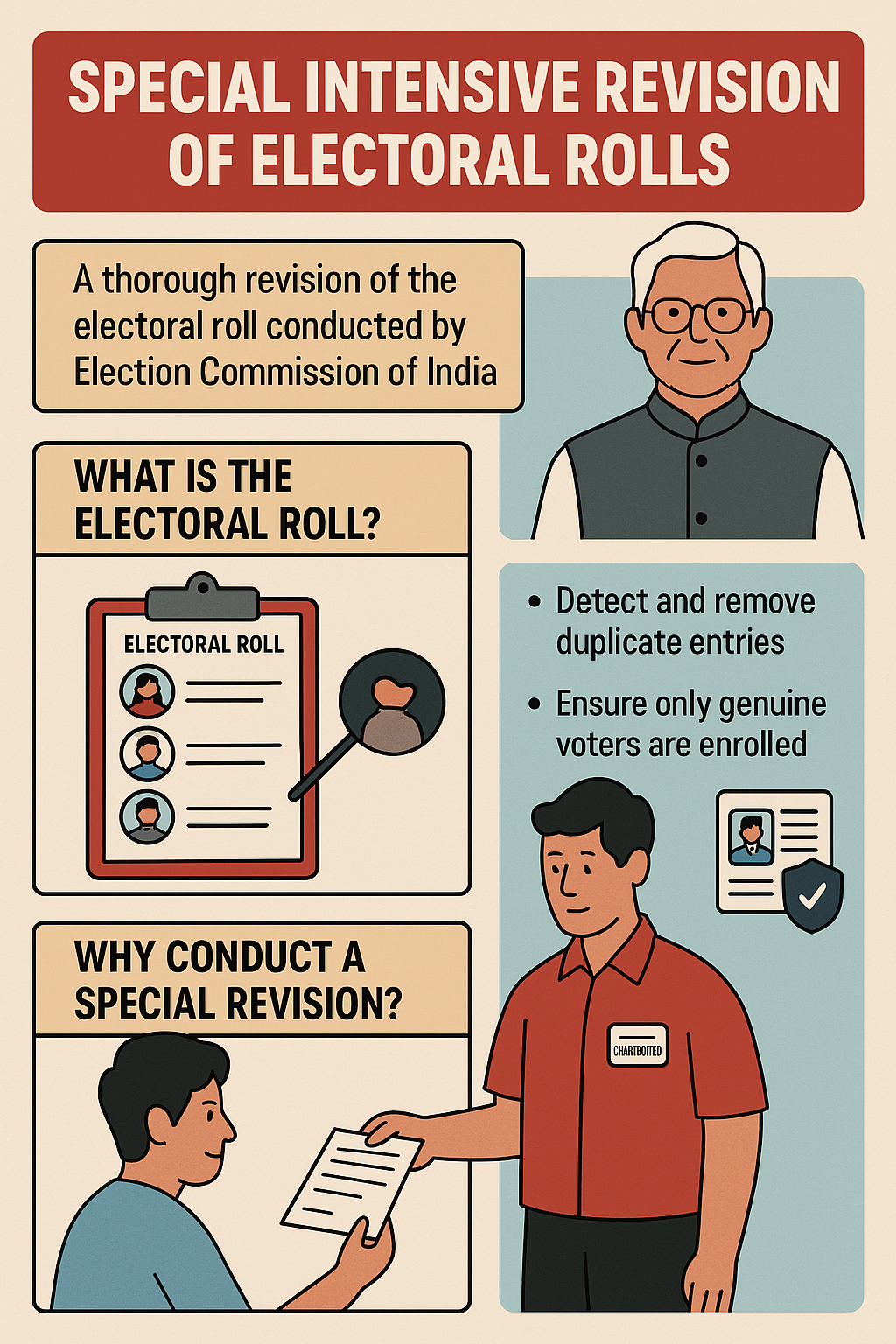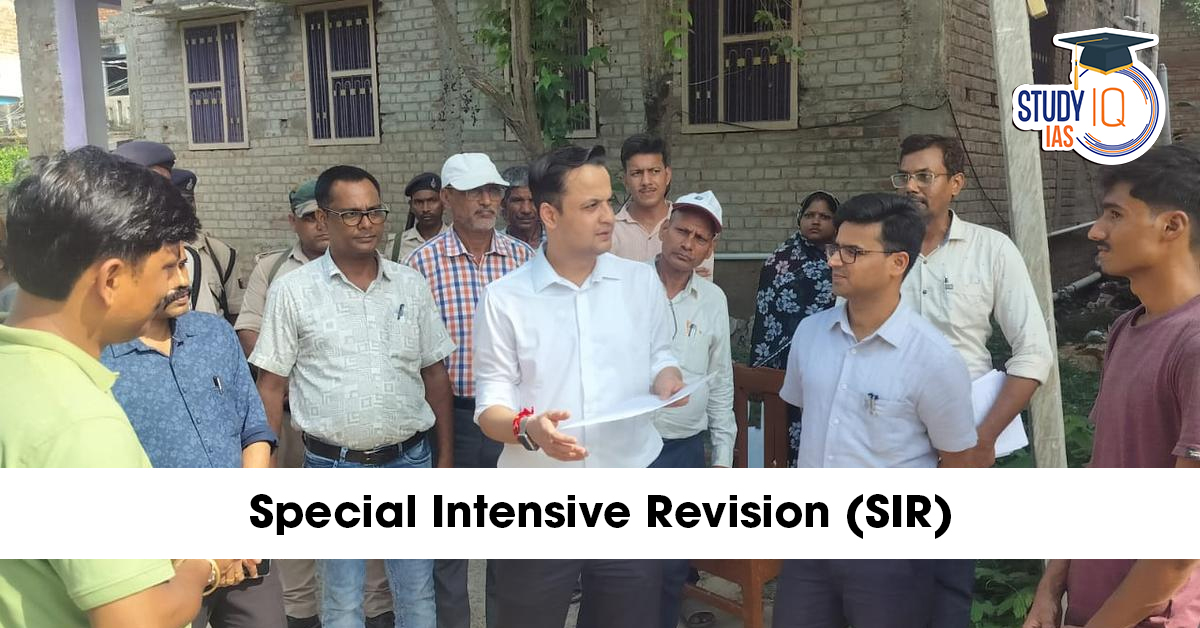Table of Contents
ECI has launched a Special Intensive Revision (SIR) in Bihar, requiring all voters to submit forms and post-2003 entrants to provide proof of citizenship. The integrity and inclusiveness of electoral rolls constitute the foundation of a strong democratic process. Consequently, the Election Commission of India (ECI), under its constitutional authority, has commenced a Special Intensive Revision (SIR) of the electoral rolls in Bihar in preparation for the 2025 legislative assembly elections.
This Special Intensive Revision (SIR) exercise, last performed in 2003, has acquired importance not just because of its magnitude, aiming at over 80 million voters, but also for its ramifications on voter enfranchisement, citizenship verification, and migrant rights. The present SIR is under meticulous examination owing to its capacity to transform the political dynamics of one of India’s most populous states.
The Supreme Court in Association for Democratic Reforms vs ECI (2025) has directed the Election Commission of India (ECI) to:
- Make the draft electoral roll more accessible and searchable.
- Provide reasons for the exclusion of voters so that they can challenge the decision.
More in News
- This came in the backdrop of the Special Intensive Revision (SIR) exercise in Bihar, intended to “remove non-citizens” from voter lists.
- The SC’s order is being compared to its 1995 judgment in Lal Babu Hussain vs ERO, where the Court struck down arbitrary attempts by the ECI to declare voters as “non-citizens” without credible evidence.
Special Intensive Revision (SIR) in Bihar: Impact of the SC’s Order
- Protection of voters’ rights: Citizens cannot be arbitrarily excluded without explanation.
- Transparency and accountability: ECI is compelled to disclose reasons for exclusions, preventing misuse.
- Shift of focus: From questioning citizenship to ensuring accuracy of electoral rolls.
- Institutional balance: Continues the history of the SC nudging the ECI toward fairness rather than rebuking it.
Reasons for the Issue
- Lack of legal basis for SIR: Neither the Representation of the People Act, 1950 nor the Registration of Electors Rules, 1960, mentions “Special Intensive Revision.”
- The exercise seems to rest on administrative discretion rather than statutory mandate.
- Burden of proof shifted to citizens: Citizens are being asked to prove citizenship afresh, despite already being in the rolls.
- Aadhaar cards and EPIC cards (issued by the ECI itself) were initially not accepted as valid proof.
- Historical parallels: Similar attempts in Delhi and Mumbai (1994) – nearly 3 lakh people asked to prove citizenship, with limited documents accepted.
- SC in 1995 ruled that proof could only be demanded when credible evidence suggested someone was not a citizen.
Significance of the Judgment
- Reinforces universal franchise: India’s electoral history is marked by immediate universal suffrage (1950), unlike many countries where franchise was gradually extended.
- The judgment reaffirms this commitment to inclusivity and equality in voting rights.
- Constitutional balance: By directing reforms rather than invalidating the SIR outright, the SC maintained institutional balance.
- It avoided confrontation with the ECI but ensured that citizens’ rights remain protected.
- Strengthens democratic legitimacy: Elections are meaningful only if electoral rolls are accurate and fair.
- Wrongful deletions risk disenfranchising large sections of society, weakening democratic legitimacy.
- Judicial continuity: The 2025 ruling is consistent with earlier cases (1995 Lal Babu Hussain, 2017 People’s Union for Civil Liberties) where the SC emphasised natural justice, transparency, and procedural safeguards.
- Broader message: The verdict highlights that citizenship verification cannot override democratic participation.
- It reflects India’s ethos that even the poor, the homeless, or those without fixed identity documents have a right to be heard and represented.
BIHAR SIR 2025: DAILY BULLETIN 1st Aug (3 PM) till 6th Aug (9 AM)
Claims & Objections received from Political Parties w.r.t. Draft Roll
| S. No | From | No. of BLAs | Received | Disposal after 7 days |
|
National Parties |
||||
| 1 | Aam Aadmi Party | 1 | 0 | 0 |
| 2 | Bahujan Samaj Party | 74 | 0 | 0 |
| 3 | Bharatiya Janata Party | 53,338 | 0 | 0 |
| 4 | Communist Party of India (Marxist) | 899 | 0 | 0 |
| 5 | Indian National Congress | 17,549 | 0 | 0 |
| 6 | National People’s Party | 7 | 0 | 0 |
|
State Parties |
||||
| 1 | Communist Party of India (Marxist-Leninist) (Liberation) | 1,496 | 0 | 0 |
| 2 | Janata Dal (United) | 36,550 | 0 | 0 |
| 3 | Lok Janshakti Party (Ram Vilas) | 1,210 | 0 | 0 |
| 4 | Rashtriya Janata Dal | 47,506 | 0 | 0 |
| 5 | Rashtriya Lok Janshakti Party | 1,913 | 0 | 0 |
| 6 | Rashtriya Lok Samta Party | 270 | 0 | 0 |
| Total | 1,60,813 | 0 | 0 | |
Claims & Objections received directly from Electors w.r.t. Draft Roll
| Inclusion of eligible electors and
Exclusion of ineligible electors |
Received | Disposal
After 7 days |
|
| 3,659 | 0 | ||
Forms received from New electors on attaining 18 years of age or above
| Form 6 + Declaration | Received | Disposal after 7 days | |
| 19,186 | 0 | ||
- According to regulations, the Claims & Objections are to be settled by the respective ERO/AERO after 7 days.
- According to Bihar SIR orders, no name can be removed from the draft list brought out on 1st August 2025 without obtaining a speaking order from the ERO/AERO after holding an enquiry and after affording a reasonable and fair opportunity.
Draft Electoral Roll Issued in Bihar
The Election Commission of India (ECI) officially released the draft electoral roll for Bihar on 1st August 2025, after the Special Intensive Revision (SIR) exercise was completed. This was confirmed by PIB Delhi in an official press release. Draft booth-wise lists for all 90,712 polling stations within 243 Assembly Constituencies were made available to all the recognised political parties through the state’s 38 District Election Officers (DEOs).
| Key Highlights of the Draft Electoral Roll Issued in Bihar | |
|---|---|
| Draft Roll Released | 1 August 2025 |
| Total Voters in Draft | 7.24 crore |
| Reduction Since June | ~65 lakh names removed |
| Major Reasons for Deletions | Deaths (~22L), Migration (~36L), Duplicates (~7L) |
| Claims Period | 1 Aug – 1 Sept 2025 |
| Recourse Provided | Hearing mandatory for any deletion; appeals available to DM/CEO |
Voter Statistics and Major Changes
- The revised draft roll contains 7.24 crore electors who deposited their Enumeration Forms within the 25 July cutoff
- This is a decline of more than 65 lakh voters from the figure of 7.9 crore on 24 June 2025
Claims and Objections Window
The One‑Month claims and objections period is between 1 August and 1 September 2025. Electors and political parties can, during this phase:
- Submit Form 6 and Declaration forms to include omitted eligible names.
- Reject objections for purging ineligible names,
- Seek corrections for bogus entries
The Commission has made it clear that no name can be struck off the draft roll except upon a valid hearing and writing order, which is appealable to the CEO or District Magistrate
First Phase of Bihar Special Intensive Revision (SIR) Near Completion
The house-to-house survey and form collection, the first phase of the Special Intensive Revision (SIR) of Bihar’s electoral rolls, came to a close on July 25, 2025. The ECI had launched the exercise on June 24, and it has been a big operation and a topic of much discussion.
Facts Revealed till 23 July 2025
- 98.01% Electors have been covered
- 20 lakh deceased Electors reported
- 28 lakh permanently migrated Electors reported
- 7 lakh Electors found enrolled at more than one place
- 1 lakh Electors untraceable
- 15 lakh Electors’ Forms not returned
- 7.17 crore Electors’ Forms (90.89%) received and digitised
In the initial phase of Bihar SIR, the electoral rolls of all with mostly incorrect electors, and non-returning Enumeration Forms have been provided, on 20th July, to 1.5 lakh Booth Level Agents (BLAs) appointed by District Presidents from all 12 prominent political parties of Bihar.
Next Steps
- The draft electoral roll will be brought out on August 1, 2025. This is the end of the first phase of the SIR.
- A period of filing claims and objections will then run from August 1, 2025, to September 1, 2025. Citizens during this period can file objections to inclusions or deletions, and eligible individuals whose names are not on the draft roll can apply for their inclusion.
- The final roll of electors is to be published on September 30, 2025.
Bihar Special Intensive Revision (SIR): 95.92% Electors Covered
Latest reports state that Bihar’s Special Intensive Revision (SIR) of electoral rolls has in its grasp a large percentage of its electors, with 95.92% of enumeration forms received. This advancement has been achieved with only 6 days left before the deadline for submission, which is July 25, 2025.
The Election Commission of India (ECI) launched this all-encompassing door-to-door verification drive throughout Bihar on June 24, 2025, with the last updated electoral roll to be published by September 30, 2025. This is the first such intense revision in Bihar since 2003.
| Key Highlights of SIR in Bihar 2025 | ||||
| 1. | Total Electors (as on 24th June 2025) | 7,89,69,844 | Percentage | |
| 2. | Enumeration Forms Received | 7,15,82,007 | 90.64% | |
| 3. | Enumeration Forms digitised | 6,96,93,844 | 88.25% | |
| 4. | Electors not found at their addresses so far | 41,64,814 | 5.27% | |
| 4.1 | Probably Deceased electors | 14,29,354 | 1.81% | |
| 4.2 | Probably Permanently Shifted electors | 19,74,246 | 2.5% | |
| 4.3 | Electors identified as Enrolled at Multiple places | 7,50,213 | 0.95% | |
| 4.4 | Electors not traceable | 11,000 | 0.01% | |
| 5. | Total electors covered (2+4) | 7,57,46,821 | 95.92% | |
| 6. | Remaining Enumeration Forms yet to be received | 32,23,023 | 4.08% | |
Bihar Special Intensive Revision (SIR): 66.16 % Enumeration Forms Collected; 15 More Days Left
Voluntary participation of Bihar voters during the Special Intensive Revision (SIR) and incessant efforts of 77,895 BLOs and 20,603 BLOs appointed recently and other electoral officials, more than 4 lakh volunteers who are assisting the elderly, PwD, ill and weak groups along with the 1.56-lakh voluntary force of Booth Level Agents (BLAs) who have been commissioned by all recognized political parties, have led to the procurement of 66.16% Enumeration Forms.
The electors have another 15 days left to return the form. As of today, by 6.00 PM, 5,22,44,956 Enumeration Forms, that is 66.16% of the total of 7,89,69,844 (almost 7.90 crore) electors that currently exist in Bihar, have been received in the past 16 days, from the date of issue of SIR instructions on June 24, 2025.
Continuing with the same tempo on the ground, the work of gathering the Enumeration Forms could be done much ahead of the deadline, i.e. July 25, 2025.
In the last 16-day period since the initiation of the SIR exercise, 7.90 crore forms have been printed, and almost 98% forms (7.71 crore) have already been delivered to the electors whose names were included in the electoral roll as on 24.06.2025, i.e. the date of the SIR order.
Initial Phase of Bihar Special Intensive Revision (SIR) Completed
The first phase of the Special Intensive Revision (SIR) of electoral rolls in Bihar has been largely done, as per a communication made by the Election Commission of India (ECI) on July 6, 2025. This all-important exercise, which has commenced on June 24, 2025, is intended to update and validate the state’s electoral rolls in the run-up to the coming Assembly elections.
First Phase SIR Process
In the first phase of this process, the major emphasis was on the enumeration form printing and distribution to Bihar’s almost 7.90 crore voters. The ECI has already confirmed that the forms have been provided to all reachable voters. As of July 6, more than 1.69 crore enumeration forms (i.e., about 21.46% of the overall electorate) have been collected, with a huge increase in collections within the last 24 hours. Parallelly, the forms are being uploaded, of which 7.25% have already been digitised.
Notwithstanding resistance and legal suits from some opposition parties apprehensive of disenfranchisement, the ECI has reaffirmed that the SIR is being implemented strictly according to the guidelines dated June 24, 2025. Electors can send in their forms and supporting documents up to July 25, 2025.
Draft electoral rolls, including names received on the forms, will be notified on August 1, 2025, following which there will be a claims and objections period to enable further inclusion and corrections. The ECI has employed a massive force of Booth Level Officers (BLOs), extra officers, and almost 4 lakh volunteers to enable the process, especially for old, PwD, ill, and vulnerable persons.
Updates on Bihar Assembly Election 2025
| In SIR Battle, SC Referred to M.S. Gill vs. Chief Election Commissioner, 1977 Verdict |
What was the Verdict?
|
What is Special Intensive Revision (SIR)?
- Special Intensive Revision (SIR) is a comprehensive, house-to-house verification process to update and verify electoral rolls.
- Legally backed by Section 21(3) of the Representation of the People Act, 1950, and Article 324(1) of the Constitution.
Objectives
- Remove ineligible or duplicate voters, including illegal immigrants.
- Ensure only genuine Indian citizens aged 18+ are included in the electoral rolls.

Why It’s Needed
- Large-scale additions and deletions over the last two decades.
- Increased urbanisation and migration have led to multiple voter registrations.
- Rising concerns over illegal immigrants and demographic manipulation, especially in border states like Bihar.
Key Features
- Applicable to all voters, with stricter checks for post-2003 registrants.
- Mandatory submission of enumeration forms and proof of birth/citizenship.
Document Requirements by Birth Year
- Born before July 1, 1987: Own birth document is sufficient.
- Born between 1987 and 2004: Personal document + one parent’s proof of citizenship.
- Born after 2004: Personal document + both parents’ citizenship proofs.
- Forms can be submitted online via the ECINET app or the official ECI website.
Significance of SIR
- Enhances the accuracy and integrity of electoral rolls.
- Builds public confidence in the electoral process.
- May serve as a model for a nationwide voter verification
Types of Electoral Roll Revision
Intensive Revision
A complete overhaul of the electoral roll carried out afresh without reference to previous lists.
- Booth-level officers conduct at least two rounds of household verification to ensure accuracy.
- The Election Commission of India (ECI) conducts a “Special Intensive Revision” (SIR) of electoral rolls under the provisions of Section 21(3) of the Representation of the People Act, 1950.
Summary Revision
Involves updating the existing roll rather than creating a new one.
- No house-to-house verification; changes are incorporated based on claims and objections received before the final publication.
Special Summary Revision
- Ordered by the Election Commission if significant inaccuracies or undercoverage are detected.
- The EC may modify the standard procedure as needed for better accuracy.
Partly Intensive and Partly Summary Revision
A mixed approach where the draft roll is published, select areas are verified through household visits, and the claims/objections process is followed.
Chronology of Electoral Roll Revisions in India
- 1950: Section 23 of the Representation of the People Act provided for annual revision with March 1 as the qualifying date.
- 1952: Post-first general election, the EC directed annual revisions to cover one-fifth of each state yearly, ensuring complete revision before the next polls.
- 1956: Annual intensive revision was targeted in urban areas, regions with migrant workers, and localities experiencing large population shifts.
- 1957: After the Lok Sabha polls, EC directed intensive revision for one-third of the state area each year for the next three years; 1961 focused on urban and migratory areas.
- 1960: Amendments led to annual roll revisions between January 1 and January 31.
- 1962: Post-election, summary revision was deemed sufficient for 1963 and 1964. Intensive revision resumed for 40% of the country in 1965 and the remaining 60% in 1966.
- 1966: District Election Officers were appointed; summary revisions took place in 1969-70 and 1975.
- 1976: No Lok Sabha election due to the Emergency; summary revision was conducted instead
- 1983: Staggered intensive revision began for rural constituencies ahead of the 1985 general elections.
- 1987-88: All constituencies underwent intensive revision; a special revision was conducted in 1989.
- 1992: Summary revision was ordered, followed by an intensive revision in 1993 and the introduction of EPIC cards.
- 1995: Intensive revision was implemented.
- 1999-2000: Due to computerisation, no intensive revision took place in these years.
- 2002: Special intensive revision occurred in 20 states; 7 states saw intensive revision in 2003–04.
Issues Raised with Intensive Revision of Electoral Rolls
- Potential Mass Disenfranchisement: A large number of eligible voters, especially the poor, uneducated, and marginalised, may be excluded due to the lack of required documents (like birth certificates, matriculation certificates, passports).
- Bihar’s low documentation rates mean millions may lose their constitutional right to vote.
- Administrative Feasibility & Timeline: The scale of the exercise is massive (nearly 4.7 crore people in Bihar alone), with a tight timeline (just one month).
- Electoral Registration Officers are unlikely to have the capacity to process and verify such a high volume of applications in such a short period, leading to errors or exclusion.
- Exclusion Due to State Capacity Failures: Many citizens lack documents not due to personal fault but because the State failed to provide birth registration, quality education, or timely certificates.
- Penalising citizens for administrative deficiencies is unjust.
- Lack of Inclusion of Accessible Documents: Aadhaar and ration cards, which are widely held, are not accepted as proof, whereas less common documents are allowed.
- This increases the burden on the poorest and most vulnerable, who are least likely to have “elite” documents.
- Migration and Deaths Not Properly Accounted: Large numbers of permanent migrants and deceased persons from the 2003 rolls distort estimates and add confusion regarding who needs to reapply.
- Migrants who have moved states may be excluded from both their new and old constituencies.
- Disproportionate Impact on Marginalised Groups: Women, minorities, and deprived castes—who already have lower document possession and educational attainment—are at greater risk of exclusion.
Constitutional and Legal Framework of Electoral Rolls
- According to Article 324 of the Indian Constitution, the Election Commission of India holds exclusive authority over the supervision, direction, and management of electoral roll preparation and election operations.
- Article 326 reaffirms the right of every citizen of India aged 18 years and older to be registered as an elector.
- The Representation of the People Act 1950 (RP Act) and the Registration of Electors Rules, 1960 (RER) regulate the formulation, amendment, and upkeep of electoral rolls.
- According to the RP Act, electoral rolls are compiled on a constituency basis for the state assembly, while the Lok Sabha rolls consist of these segment rolls.
- A framework including Chief Electoral Officers (CEOs), District Election Officers (DEOs), Electoral Registration Officers (EROs), Assistant EROs, and Booth Level Officers (BLOs) is utilised to oversee this comprehensive activity.
- The RP Act has provisions that limit enrolment to Indian citizens (Section 16) and stipulates qualifying standards, including a minimum age of 18 years and “ordinary residence” within the constituency (Section 19).
- Section 20 further elucidates that property ownership inside a constituency does not suffice to establish one as ‘ordinarily resident.’
- Exemptions apply to armed services personnel, government officials stationed abroad, and holders of constitutional offices, who are regarded as habitually resident in their home constituencies.
- Section 20A, introduced in 2010, grants voting rights to Non-Resident Indians (NRIs) according to their passport address, enabling them to register in their original constituency.
Special Intensive Revision: Background and Developments
- The ongoing Special Intensive Revision (SIR) effort began on 25 June 2025, with enumeration forms issued to more than 80 million voters in Bihar.
- The editing process will conclude with the publishing of the final electoral roll by 30 September 2025, strategically timed before the Bihar Assembly elections set for November 2025.
- The ECI’s order dated 24 June 2025 mandates a change due to significant migration and urbanisation in Bihar over the last twenty years, leading to various modifications in the voter list.
- These modifications elicit apprehensions over duplicate or fraudulent entries, necessitating a new beginning to guarantee accuracy and integrity.
- Significantly, in contrast to the 2003 SIR, which involved enumerators doing house-to-house verification of voters, the 2025 SIR mandates that all current electors submit enumeration forms to BLOs. Significantly:
-
- Voters registered prior to January 2003 need only submit a copy of the 2003 electoral roll extract.
- Voters registered after January 2003 must provide supplementary documents, including evidence of their date and place of birth, as well as comparable documentation for their parents.
- Appeals may be submitted to the District Magistrate within 15 days of the final roll publication, and subsequently to the Chief Electoral Officer within 30 days, under the Registration of Electors Rules, 1960.

Purpose and Legal Basis of the SIR
- The legal basis for SIR is established in Section 21 of the RP Act, which permits summary revision before general or bye-elections and authorises the ECI to perform a special revision for documented reasons.
- In light of significant demographic shifts, particularly urban migration and the potential for duplication, the ECI activated this capability to revalidate all entries.
- The SIR primarily seeks to eliminate ineligible or duplicate voters; nonetheless, it has faced criticism for its perceived overreach, particularly concerning citizenship verification, a function not constitutionally assigned to the ECI.
Migrant Labourers and the “Ordinary Residence” Clause
- The most contentious issue pertains to the exclusion of migrant voters grounded in a restrictive interpretation of “ordinary residence” as delineated in Section 19 of the RP Act. The phrase has been historically construed with leniency.
- The Gauhati High Court in the Manmohan Singh case (1999) determined that ordinary residence denotes a habitual, permanent dwelling rather than a transient or brief stay.
- Migrant labourers, particularly from Bihar, frequently return home seasonally and preserve robust familial, economic, and social connections. Their removal from the electoral rolls of their home constituencies due to stringent interpretations may lead to disenfranchisement, particularly if they are unable to register at their temporary workplaces.
- The Periodic Labour Force Survey (2020–21) indicates that around 11% of India’s population migrated for employment, amounting to around 150 million voters.
- A significant number of these workers reside in temporary housing, frequently relocating from one location to another. Nevertheless, they persist in voting in their home states, where their family reside and properties are situated.
- Excluding individuals from the rolls might undermine the democratic process, as their removal would not be predicated on their purpose or affiliation with the constituency, but rather on their physical absence.
Concerns Over Citizenship Verification
- Petitioners in the Supreme Court have expressed significant concern that the SIR operates as an unofficial citizenship verification system, which exceeds the legal authority of the ECI. Citizenship verification is the responsibility of the Ministry of Home Affairs, not the Election Commission of India.
- The mandate for voters registered post-2003 to provide evidence of their and their parents’ birth and residency is regarded as an undue hardship, especially for the disadvantaged, old, or individuals from remote areas who may lack such documents.
- Furthermore, the Election Commission of India has always depended on self-declaration and Aadhaar as adequate verification of identification.
- According to Rule 8 of the RER (1960), persons must furnish information to the best of their ability when requested. Nonetheless, the current SIR’s absence of Aadhaar from the list of acceptable documents has exacerbated challenges for voters attempting to verify their eligibility.
- The logistical challenge of validating citizenship for around 30 million voters registered after 2003 within a few months has been considered unfeasible and impractical.
Pros and Cons of the SIR in Bihar
| PROS | CONS |
| Ensures clean and accurate electoral rolls free from duplications and ineligible voters. | Risk of disenfranchising eligible citizens, especially migrants and the poor, due to strict documentation requirements. |
| Strengthens the credibility of elections by removing non-citizens. | Burden on BLOs and EROs to verify documents in a limited timeframe. |
| Potentially reduces voter fraud. | Excludes Aadhaar, creating issues for citizens relying on it as a primary identity proof. |
| Encourages a robust process of verification. | Converts ECI into a de facto citizenship verification agency, outside its mandate. |
| Sets a precedent for similar exercises nationwide to clean electoral rolls. | May exclude habitual residents who do not meet narrow interpretations of “ordinarily resident.” |
Way Forward
- The existing SIR process, though well-meaning, requires substantial modifications to prevent widespread disenfranchisement and unnecessary hardship. The subsequent recommendations are deemed essential:
- Reassess timeframes: The ECI must guarantee that the ambitious timeframes for the SIR facilitate comprehensive verification without haste or inaccuracies. Booth Level Agents (BLAs) of political parties must actively engage in promoting transparency.
- Acknowledge Aadhaar and Other Standard Documents: The omission of Aadhaar may negatively impact marginalised populations. The Supreme Court’s interim ruling (10 July 2025) instructing the ECI to recognise Aadhaar, Voter ID, and Ration Card as acceptable papers shall be executed without delay.
- Safeguard Migrant Electorate: The removal of migrant workers from local electoral rolls warrants re-evaluation. Their significant connections to their original domicile render their exclusion a violation of the principle of universal adult suffrage as stipulated in Article 326. Revisions to the RP Act and RER may be necessary to align with the contemporary realities of migration in India.
- Investigate Remote Voting Mechanisms: To ensure genuinely inclusive elections, initiatives such as remote voting, postal ballots, or blockchain-secured systems should be tested to enhance participation among mobile and migrant communities.
- The balance between inclusion and exclusion: In legal terms, improper exclusion of qualified voters is more severe than wrongful inclusion of ineligible voters. The ECI should embrace a more inclusive strategy that prioritises enfranchisement.
- The Special Intensive Revision (SIR) of the electoral rolls in Bihar signifies both an opportunity and a difficulty. It seeks to cleanse the electoral process by removing duplicates and ineligible entries.
- Conversely, its implementation engenders valid apprehensions about disenfranchisement, particularly affecting migrants and marginalised groups.
- The ECI must balance the preservation of electoral roll integrity with the protection of the fundamental right to vote, a pillar of Indian democracy.
- As the ECI contemplates expanding this SIR model to more states, its methodology in Bihar may establish a benchmark for reconciling administrative rigour with constitutional empathy.


 RUDRA Brigade: The Biggest Transformatio...
RUDRA Brigade: The Biggest Transformatio...
 Project Gaja-Lok: INTACH Launches Landma...
Project Gaja-Lok: INTACH Launches Landma...
 India to Host Global Big Cats Summit 202...
India to Host Global Big Cats Summit 202...



















